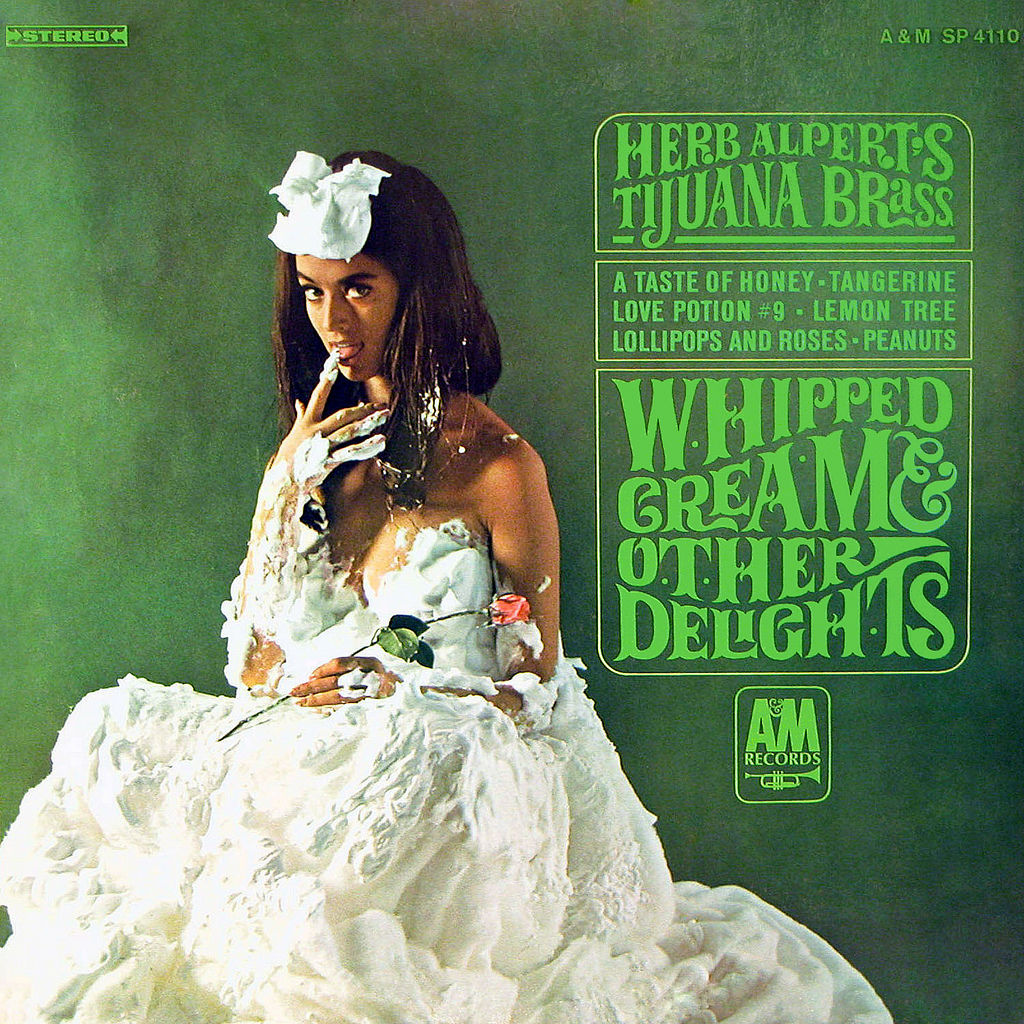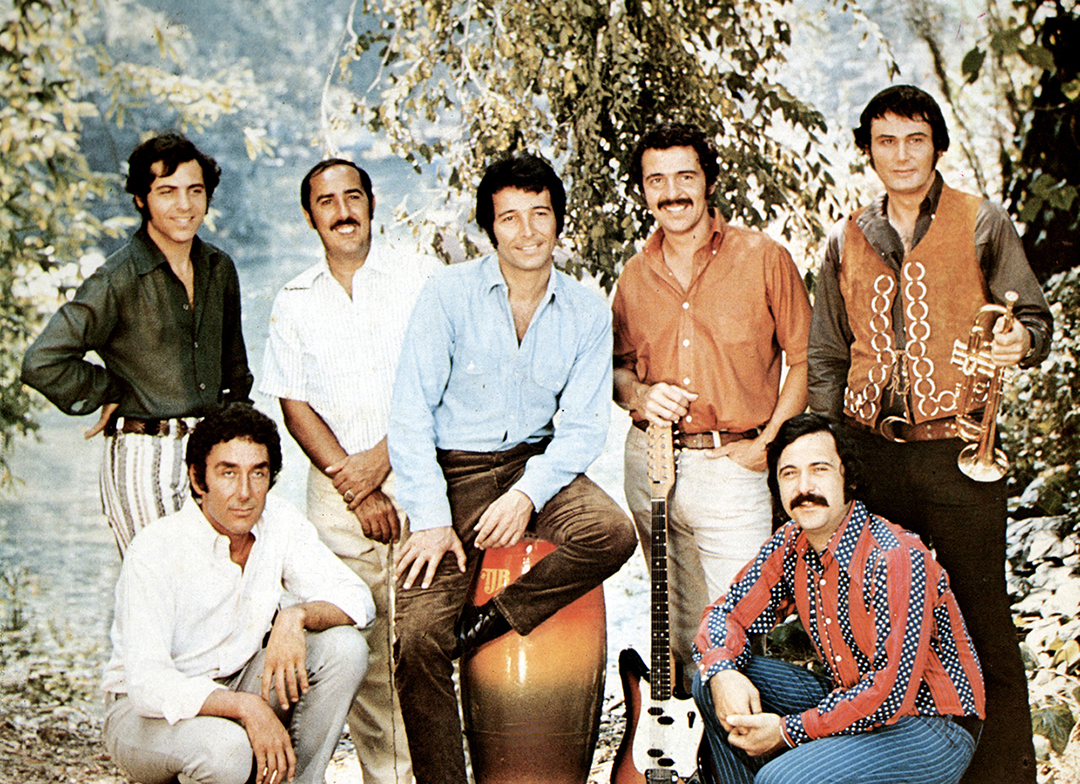THE REAL STORY BEHIND HERB ALPERT’S ICONIC ‘WHIPPED CREAM & OTHER DELIGHTS’ ALBUM COVER, 50 YEARS LATER

Courtesy Photo Whipped Cream & Other Delights by Herb Alpert & The Tijuana Brass.
As Herb Alpert remembers it, he was in a recording studio one day in 1965 when the art director for A&M, the label Alpert co-owned, showed him the photograph that would soon grace one of the most memorable LP covers of all time. “My first reaction was, ‘Holy shit, man. Too racy,’” Alpert says. “Obviously now it would hardly register, but at the time I thought, ‘Wow, that’s a little much.’ And I didn’t know, quite frankly, whether it reflected the album — the music I was doing at the time. But we decided to go with it. Obviously that was fortuitous.”
It was, because the LP in question, Whipped Cream & Other Delights, attributed to Herb Alpert’s Tijuana Brass, was his breakout album, and the photo in question was the now iconic shot of a seemingly nude, doe-eyed young woman sunk up to her décolletage in what appears to be a giant pile of the titular dessert topping. Looking askance at the camera, she touches a long cream-tipped finger to her lips. On her head is an added dollop of white, evoking, maybe, one of Billie Holiday’s signature gardenias. In her left hand she absently holds a long red rose, perhaps a sop to notions of traditional romance, or maybe an unneeded effort by the photographer to add color and more visual interest.
Herb Alpert’s ‘Love Affair’ Song Premiere: Listen Now
From a straight male point of view, and perhaps from others’, this was the sexiest album cover of the 1960s, as many then-adolescent boys can to this day vividly recall. Whether or not it accurately reflected Alpert’s gently swinging, mariachi-inflected instrumentals, the photo surely help propel Whipped Cream & Other Delights, released in 1965, into the number-one slot on Billboard’s list of top-selling LPs for 1966, beating out The Beatles, Frank Sinatra, Nancy Sinatra, The Rolling Stones, The Mamas and the Papas, Lou Rawls, and Barbra Streisand. This triumph wasn’t a fluke solely attributable to art direction: Alpert and the Tijuana Brass’s Going Places (also 1965) and What Now My Love (1966) held the third and fifth spots on the 1966 year-end chart despite pleasant yet far more anodyne covers. Two songs on Whipped Cream, “Lolllipops and Roses” and the album’s title song, became swingers’ anthems after they were used to play on contestants on ABC-TV’s The Dating Game.

GAB Archive/Redferns Herb Alpert & The Tijuana Brass
According to Alpert, Whipped Cream also launched him as a lucrative touring act. (To that point the Tijuana Brass had been a loose group of studio musicians, mostly Wrecking Crew members, with Alpert overdubbing his own trumpet.) Fifty years later, he’s still recording and still on the road, including an upcoming two-week stand at Manhattan’s Cafe Carlyle, beginning May 31, with his wife, singer Lani Hall.
The Whipped Cream model was a Seattle woman named Dolores Erickson, now 80 (as is Alpert) and a working artist. Back in the early ’60s she ran in the same L.A. social circles as Alpert, along with Jerry Moss, his eventual partner at A&M, and, maybe most importantly, the label’s eventual art director, Peter Whorf. Erickson, who aside from her modeling career was also briefly under contract at Paramount — you can spot her, fleetingly, in Jerry Lewis’ The Ladies Man (1961) — remembers frequent jaunts to Tijuana with Alpert, then a songwriter and producer, and “our whole group” to see the bullfights. These excursions inspired Alpert’s hit single “The Lonely Bull,” which launched the Tijuana Brass sound in 1962. Erickson attended the recording session, in Alpert’s garage. “It was one of those wonderful experiences, being young, aspiring to success, everybody cheering everybody on,” she remembers.
By the time Whipped Cream came along in 1965, Erickson was an old hand at album shoots, having appeared on records for Nat “King” Cole, Stan Kenton, and the Kingston Trio, as well as an LP of Berlioz overtures, conducted by Sir Adrian Boult, for which she was photographed in close-up with flowers in her hair, looking vaguely like a Frida Kahlo self-portrait. The Whipped Cream shoot, both Erickson and Alpert say, was entirely Whorf’s concept. He shot it himself in his home studio, a converted garage. Erickson, who wore a bikini with the shoulder straps pushed down and hidden, was for the most part surrounded by cotton batting and many cans’ worth of shaving cream because actual whipped cream turned runny and smelly under hot lights. The real thing was used only on her head and on the index finger she touched to her lips.
Was it an odd assignment, trying to look enticing while sitting in a big pile of shaving cream? “It wasn’t unusual for me,” she insists. “I’d worked on a catamaran in the middle of a storm for a cigarette commercial. This was just another job. Peter always told me to make love to the camera. We just had a lovely time.” Adding to the not-really-very-sexy-at-all atmosphere was the fact that Erickson was three months pregnant with her son, Brett. How does he feel about having been an inadvertent participant in such a milestone of Baby Boomer erotica? “Oh you know how it goes,” Erickson says, laughing. “It’s just ‘mom.’”
A version of this article was originally featured in the May 28 issue of Billboard.
